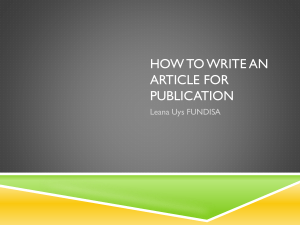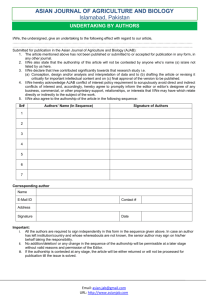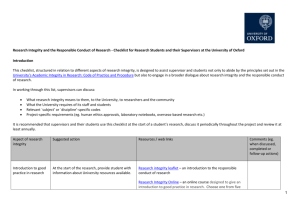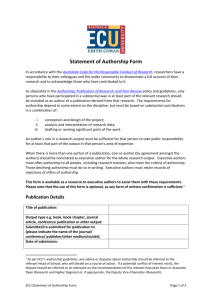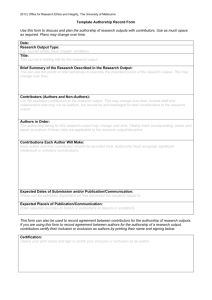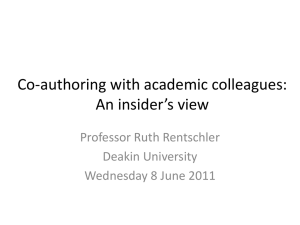Responsible Authorship and Peer Review
advertisement
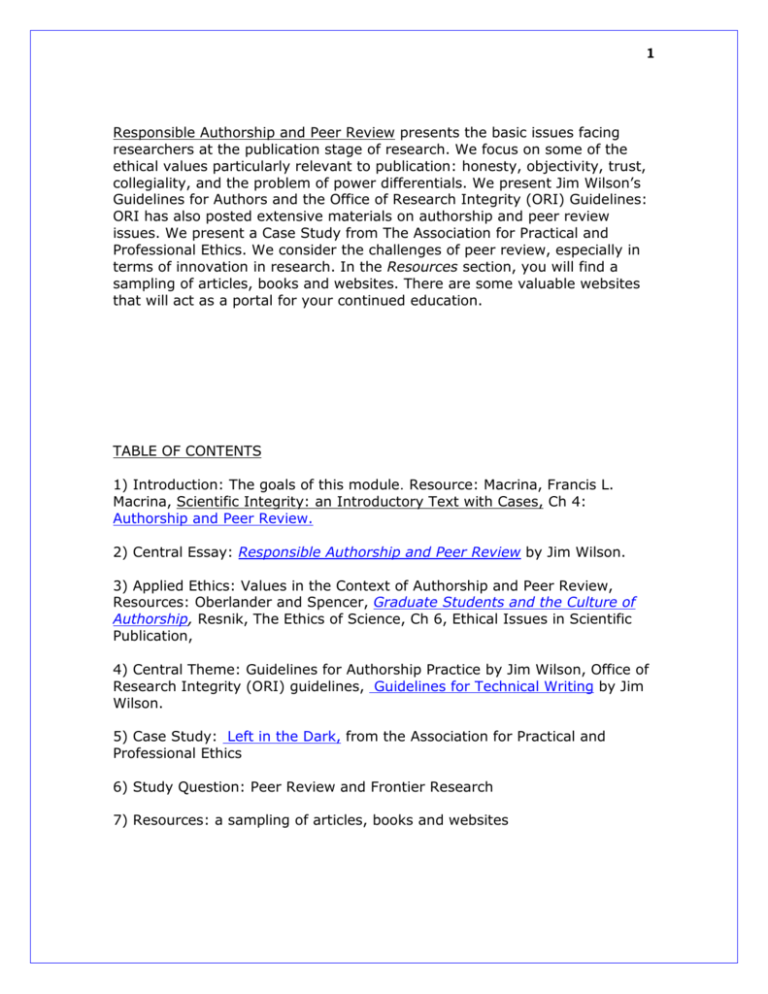
1 Responsible Authorship and Peer Review presents the basic issues facing researchers at the publication stage of research. We focus on some of the ethical values particularly relevant to publication: honesty, objectivity, trust, collegiality, and the problem of power differentials. We present Jim Wilson’s Guidelines for Authors and the Office of Research Integrity (ORI) Guidelines: ORI has also posted extensive materials on authorship and peer review issues. We present a Case Study from The Association for Practical and Professional Ethics. We consider the challenges of peer review, especially in terms of innovation in research. In the Resources section, you will find a sampling of articles, books and websites. There are some valuable websites that will act as a portal for your continued education. TABLE OF CONTENTS 1) Introduction: The goals of this module. Resource: Macrina, Francis L. Macrina, Scientific Integrity: an Introductory Text with Cases, Ch 4: Authorship and Peer Review. 2) Central Essay: Responsible Authorship and Peer Review by Jim Wilson. 3) Applied Ethics: Values in the Context of Authorship and Peer Review, Resources: Oberlander and Spencer, Graduate Students and the Culture of Authorship, Resnik, The Ethics of Science, Ch 6, Ethical Issues in Scientific Publication, 4) Central Theme: Guidelines for Authorship Practice by Jim Wilson, Office of Research Integrity (ORI) guidelines, Guidelines for Technical Writing by Jim Wilson. 5) Case Study: Left in the Dark, from the Association for Practical and Professional Ethics 6) Study Question: Peer Review and Frontier Research 7) Resources: a sampling of articles, books and websites 2 1) Introduction In Module 1 Research Ethics: an Introduction, we talked about both the range of stakeholders and the kinds of obligations involved in the process of making decisions with a moral component. In his essay, Authorship and Peer Review, Jim Wilson, Industrial Engineering, continues this discussion, focusing on the complexity of decision making when dealing with the publication phase of research. In this module we will investigate some of the current issues in authorship practices and peer review, both formal and informal. We will also review the guidelines developed by Dr. Wilson, as well as some of the government regulations. We can divide the issues of authorship into two general categories: 1) what happens during the research itself and 2) what happens during the reporting process. In the former, we see the ethical values of honesty and objectivity as taking a central role; in the latter, the values of collegiality, trust, openness and justice are emphasized – one of the most important traditions in science is the sharing of information. Feynman, in saying we can’t fool ourselves, is talking about both categories. E.g., “Negative results that might be important to other researchers or the public should be mentioned” (Steneck, 137). Authorship is in many ways about relationships and when we look to authorship guidelines we are attempting to sort out the complex professional, collegial and personal relationships that become part of the mix of writing and publishing research articles and reports. The singleauthored work, working alone in an office, field or lab, is very rare: the norm now is multi-authored papers. This is especially true given the increase in both multidisciplinary projects and tie-ins between academia and business. One of the challenges given the many different sorts of contributions to a research project is how to assign levels of responsibility. “The first principle is that you must not fool yourself—and you are the easiest person to fool. So you have to be very careful about that. After you’ve not fooled yourself, it’s easy not to fool other scientists. You just have to be honest in a conventional way after that…One example of the principle is this: If you’ve made up your mind to test a theory, or you want to explain some idea, you should always decide to publish it whichever way it comes out. If we only publish results of a certain kind, we can make the argument look good. We must publish both kinds of results.” Richard Feynman, Cargo Cult Science, Surely You’re Joking, Mr. Feynman. W.W. Norton & Co, 1985. 343. “In essence the module’s central thesis is simply this: the proper functioning and continued advancement of the scientific enterprise depends critically on individual scientists living up to the standards of ethical conduct so memorably articulated by Feynman—not only in the design, execution, and documentation of their research projects, but also in their response to the challenges of responsible, professional peer review." Dr. Jim Wilson, Responsible Authorship and Peer Review, p. 17 3 In addition, the research environment, whatever the discipline, is usually a pressured one. Research and the resulting authored papers are the currency of academia, the way we show our productivity, the ticket to jobs, promotions and renown in our field. Collegiality problems –interpersonal relationships are at the heart of many arguments over authorship; “relationships gone south” can result in bitter professional arguments. How do we divide up the responsibilities and how do we assign proper credit in group endeavors where ideas build upon each other? A famous example of a “relationship gone south” in the research environment is that of the publication of the discovery of the helical structure of DNA. This groundbreaking work on genetic structure was a team effort, but the data sharing was problematic at best and involved all sorts of complexities of time, place and personality. One of the most contentious arguments that shadowed the publication of the structure of DNA was that of lack of credit given to Rosalind Franklin, who did the original X-ray crystallography work that was critical to developing the model of the molecule. In this situation, problems of honesty and fairness occurred in both stages of the work, pre-publication in terms of data sharing and during the publication phase. “Authorship encompasses two fundamental principles: contribution and responsibility. An author must make a significant intellectual or practical contribution to the work reported in the paper. With such authorship goes the responsibility for the content of the paper. By keeping such concepts simple, the qualitative and quantitative aspects of these contributions and the precise nature of the responsibilities are left open to interpretation” (Macrina, Francis L. “Authorship and Peer Review.” Scientific Integrity, 59). As Macrina notes, although the concepts may seem straightforward, there is still much ambiguity and a range of practices across the disciplines occur. But Franklin stopped her work on DNA because she was frustrated with a strained environment at King’s, one that pitted her against her colleagues. In an institutional culture that barred women from the dining room and other social venues, she was denied access to the informal discourse that is essential to any scientist’s work. Seeing no chance for a tolerable professional life at King’s, Franklin decided to take another job. As she was preparing to leave, she turned her X-ray photographs over to her colleague Maurice Wilkins. …Then, in perhaps the most pivotal moment in the search for DNA’s structure, Wilkins, a longtime friend of Crick, showed Watson one of Franklin’s photographs without Franklin’s permission. Watson recalled, "The instant I saw the picture my mouth fell open and my pulse began to race." To Watson, the cross-shaped pattern of spots in the photo meant that DNA had to have a helical structure. Franklin’s photograph was critical in solving the problem, as Watson admitted in his 1968 book; The Double Helix...Crick later said the data in the report enabled him to reach the significant conclusion that DNA has two chains running in opposite directions. Although Franklin was listed in the acknowledgements section with other scientists, there was no specific mention of her contributions…Was it unethical for Wilkins to reveal the photographs, or for Perutz to hand over the King’s report? How should Watson and Crick have recognized Franklin for her contribution to their paper? For decades, scientists and historians have wrestled over these issues.” A Structure for Deoxyribose Nucleic Acid by J. D. Watson and F. H. C. Crick (1) 4 3) Applied Ethics: Values in the Context of Authorship and Peer Review In module 1 we commented that values in the research community are not different from those that we follow in our daily lives whatever our job. In addition, though research ethics examines those values in the context of our professional lives. The first stage of research when a team is working on gathering data depends on the values of honesty, objectivity and trust. When we record data we are obligated to others in our group to be honest; we are obligated to objectively follow our project through, whatever the results, whether or not our hypothesis or ideas are validated or not. And we necessarily trust each other to follow these values. Moreover, the public trusts us to follow these values: we have an obligation to the public to be honest and objective in gathering the information we will share with them. The second stage of research, the publication stage, necessarily is built upon these ethical principles. In addition, collegiality, openness, fairness, and accountability are critical to the dissemination of new knowledge. Challenges of large research projects involve fairness in dividing up the work, equitable distribution of responsibility, and justice in giving credit. This can become quite complex: e.g., the human genome project involved many people of diverse skills, even from different countries. There were many publications resulting from the work at different times and reporting on different aspects. Given the increasing variety of roles that go into publication, the boundaries that are considered a “significant intellectual contribution” can become unclear. Thought Question: In the box at the right, David Resnik articulates idea for a fair distribution of credit. This approach is increasingly being utilized. Historically, the primary author had the overall responsibility for the paper. Here, the responsibilities would be divided up. Would this type of credit listing help researchers in their attempt, as Jim Wilson notes, to “live up to standards of ethical conduct?” Or would the overall accountability become too dilute? “I suggest that an effective way of dealing with this problem would be to create new categories and designations, such as ‘writer,’ ‘data collector,’ ‘technician,’ ‘statistician,’ in addition to the forms of recognition that scientists currently use…If scientists adopted and used these additional categories, credit allocation could become more clear, fair and accurate than it is under the current system…The motion picture, television, newsprint and music industries have for many years used clear and accurate methods for allocating credit. Is it too much to ask that science, the paradigm of clarity and accuracy, adopt methods that are more precise than its current ones?” Resnik, The Ethics of Science, 107. 5 Power differentials in the workplace occur in all jobs, but in the research community the role of students and post-docs can be particularly challenging. Necessarily, students and post-docs rely heavily on their work with higher ranking researchers to help them begin to achieve their professional goals. They are often key workers in the trenches of a project as they gain currency in the field. On the other hand, researchers already climbing the rungs of academia (or in a related business enterprise) will be relying heavily on publication to advance their careers, and may have more at stake in terms of productivity. A full professor may feel a different sort of obligation towards an associate professor seeking tenure than a post doc, therefore giving a more prominent authorship credit to the former rather than the latter. A post doc may feel more competitive than obligated to a graduate student working under their direction and thus relegate a student’s contribution to a footnote, rather than joint authorship. Sorting out the differing moral obligations that make up a particular publication demands an understanding of the specific context of the work, as well as a realization of the climate of a specific workplace. This sort of unstated understanding or etiquette may differ between disciplines as well, adding to the complexity of authorship practices. In Graduate Students and the Culture of Authorship, Sarah E. Oberlander and Robert J. Spencer describe two practices that often occur in these sorts of situations: honorary authorship and ghost authorship. Honorary authorship is when an individual receives credit without having done substantial work on the project. This practice is common in some fields where the director of a lab is considered a major author, even if not involved at all with a specific project. “Informal institutional ‘policies’ may also dictate that certain individuals (e.g., department chairs, owners of laboratory space) be included among the authors even when their direct contributions to the paper are minimal or nonexistent” (Oberlander & Spencer, 219). Ghost authorship is the opposite situation: a major contributor is not given appropriate authorship credit. This is what happened to Rosalind Franklin in the original Nature publication. Students, post-docs and other workers low in the power structure are at particular risk for this. “Ultimately, each individual has his or her own philosophy about authorship credit. Supervisors should evaluate their own position and situational factors…Supervisors should explicitly inform students about their philosophy…Both parties should discuss abilities, tasks, supervision required, and appropriate expectations to decide what contributions merit authorship. This discussion is similar to obtaining informed consent, and signed agreements may be helpful…It is imperative that ethics courses address the power disparities that exist between students and faculty, as well as authorship credit negotiation strategies” (Oberlander & Spencer, 226, 229). 6 4) Central Theme: Principles of Authorship Given the complexity of assigning authorship, as well as the ambiguities of the research climate, specific guidelines are mandatory. Jim Wilson, in the central essay for this module outlines some of the basic rules to follow: “It follows from our main premise that the authors of a scientific work must have participated sufficiently in the work so as to take public responsibility for its content, and they must be willing and able to respond to questions about the work. Moreover, at a minimum an author should have made substantial contributions to the following aspects of the project (International Committee of Medical Journal Editors 1988): conception and design, or analysis and interpretation of data; drafting the article or revising it critically for intellectual content; writing or revising of the manuscript or review of critical sections of the manuscript; final approval of the version to be published. Beyond these minimal authorship requirements, Houck and Thacker (1990) elaborate the following principles of authorship: contribution of original ideas; design and writing of an approved protocol; responsibility for acquisition of data; responsibility for and leadership of the performance of the study; analysis and critical interpretation of data—including review and evaluation of previous studies; drafting, revising, and reviewing the manuscript; willingness and ability to defend the publication. The selection of authors for a paper should be jointly agreed by all of the collaborators on a project as soon as the group has decided on the assignment of responsibilities and workload for all members of the group. Considerations of the division of labor naturally lead to the question of who shall be the primary or lead author” (Wilson, Responsible Authorship and Peer Review, 6). Also see Jim Wilson’s Guidelines for Technical Writing for advice and guidelines for every stage of writing a scientific paper, from organizing the paper to stylistic advice. Even though these principles seem straightforward given the pressure to publish, there are certain practices that although they do occur, should be avoided. We have already noted the practices of honorary and ghost authorship. Another technique to increase publication credits is to divide up a project into smaller units of experimentation (Least Publishable Units, LPU) and publish these as separate reports. The terms salami publication, bologna or trivial publication are slang terms for this. Not only can this be misleading since the overall point of the work can be lost, it uses up resources in terms of the publication process, library cataloguing, etc. and this ultimately is an ethical issue. Duplicate publication – re-publishing the same report in a different place without noting the other publication – is another unethical practice, wasting resources and misleading colleagues. One of the challenges is to differentiate between what is done vs. what is right. The various practices noted above might not be illegal, but they are to be avoided. “Authors are usually 7 listed in their order of importance, with the designation first or last author carrying special weight, although practices again vary by discipline. Academic institutions usually will not promote researchers to the rank of tenured faculty until; they have been listed as first or last author on one or more papers. As with the principle of contribution, however, there are no clear rules for determining who should be listed as first author or the order in with other authors should be listed …Some journals have specific rules for listing authors; others do not, again placing most of the responsibility for this decision on the authors themselves” (Steneck, ORI Introduction to the Responsible Conduct of Research, 136). ORI has digitally published a wide range of materials to educate researchers as to the Responsible Conduct of Research (RCR). Their goal is not only to provide information regarding rules and regulations, but also to deepen the climate of research integrity. The overall goal of RCR education is to go beyond compliance, to encourage researchers to increase their sensitivity to the range and complexity of ethical issues. Access the ORI RCR Resources for Authorship, and you will find a host of materials. There are three modules, as well as a collection of articles. For example, an article from Nature focuses on the dilemma of accountability: The fact that simple trust may no longer suffice is a sad reflection on recent scientific history, but anything that supports public confidence in research has to be welcomed, provided that its burden is not too great. What follows is a proposal in that direction, on which we invite readers' comments. We suggest that journals should require that every manuscript has at least one author per collaborating research group who will go on record in a way that collectively vouches for the paper's standards. Each would sign a statement with reference to Nature's publication policies (see http://www.nature.com/authors/editorial_policies/index.html) 8 5) Case Study This case study is from the collection published by the Association for Practical and Professional Ethics (APPE), posted by the Online Ethics Center hosted by the National Academy of Engineering. The case, Left in the Dark, tells the story of a graduate student beginning her career and the situation she found herself in concerning the publication of her data. We will present a summary of the Case Study here in the box to the right, but reading the original Case Study, Discussion Questions and Commentaries will enable you to go more deeply into the issues. You will find that with this case, as well as others, there are two levels of questions and/or concerns; firstly, there will be specific authorship issues and then secondly, the deeper, more complex societal implications to ponder. Elizabeth is a graduate student working in the biochemistry lab of Dr. Conway, who is her thesis advisor. Feeling the pressure to publish since he has not done so in over a year, Conway begins a manuscript using Elizabeth’s data without expressly getting her consent to do so. He lists her as first author and himself as second author in the paper and submits it to a journal, utilizing his friendship with an editor to facilitate the process. When Elizabeth discovers this, she is uncomfortable since her data is only in the preliminary stages. She is not sure if she should accept this as “the way things are done,” or question what has happened. (see: Left in the Dark) This case brings up several key points we need to consider when thinking about authorship: data fraud (the issue of honest and objective reporting of results); the relationship between mentors and students, workplace relationships (issues of fairness); and, responsibilities and obligations of journal editors. There are also the deeper issues to consider, that of the underlying responsibility mentors have to students; what students owe to mentors and what workers owe to each other. There is the added complex dilemma of how to respond to the true pressures in research, e.g., pressures to publish, to be productive, to discover novelty, and push the frontier in terms of new knowledge. In terms of publication, what do researchers owe to their colleagues in their field and to the research endeavor in general? And then, the even more complex question: what do researchers owe in terms of publication to the public at large, who often help fund the work? Suggested Methodology: Access the original Case Study, Left in the Dark, read it thoroughly, including the Discussion Questions. As we did in Module 1, Research Ethics: an Introduction, we will review the case study in terms of guidelines from our 9 faculty expert, in this case, Jim Wilson. (See page 6 of this Module and of the Central Essay, Responsible Authorship and Peer Review). Wilson quotes authorship requirements as per Houck and Thacker: contribution of original ideas; design and writing of an approved protocol; responsibility for acquisition of data; responsibility for and leadership of the performance of the study; analysis and critical interpretation of data—including review and evaluation of previous studies; drafting, revising, and reviewing the manuscript; willingness and ability to defend the publication. Match up the story details from the case study with this list from Houck and Thacker. Then, review Tom Regan’s Check List from page 4 of Module 1. Doing this will enable you to see the inter-relationship of research ethics in general to the context specific concerns of authorship. For example, the “responsibility for and leadership of the performance of the study” – how does that link to Regan’s point 8: “Are any duties of justice involved? If so, who has what rights? Against whom?” Clearly, Conway has an obligation to be fair to Elizabeth and she has the right to fair treatment. But, does Conway have a right to Elizabeth’s ideas on some level, since he is sponsoring her work in his lab? Does he have a right to expect some sort of loyalty from his students for supporting them? And on a deeper level, can and should publication focus primarily on these sorts of ethical issues, or should it focus more narrowly on the real life needs of researchers in the real world? Cast a wide net in your thinking about publishing issues in terms of Regan’s Morally Relevant Questions. Again, as in the case study for Module 1, What seems to you to be resolved in your own mind? What seems to you to be unresolved in your own mind? What do you find challenging to articulate? Now review Commentary 1, as well as Commentary 2, that accompany this case. Reading their ideas when you have already struggled with this case will add to your ability to become articulate with the ethical issues and help you work on areas you are still unresolved and will help you articulate the deeper issues of this case. One of the realities of both case studies and real life situations that involve moral dilemmas is that you might have decided on how to go forward, and yet still feel the pull of the dilemma or find that there are still areas that feel unresolved to you. 10 6) Study Question: Peer Review and Frontier Research The peer review system has developed over the years into part of the culture surrounding research. In this system, both grant proposals and publications are screened by a group of peers. Your grant proposals and your publications are reviewed by colleagues in your area, with the idea that this will glean out false or misleading work or studies that are lacking in importance or relevance. But the system has always been fraught with difficulty. Thomas Kuhn has emphasized the societal dimensions of research: in his groundbreaking work Science and Scientific Revolutions he articulated the idea of paradigms, saying that the research endeavor is consensus driven, the questions asked are in the context of what is known. Thus, frontier, groundbreaking work meets resistance. If the gatekeepers are other researchers, truly innovative ideas may be rejected at the doorway. Jim Wilson discusses this problem, noting for example, the difficulty Nobel Prize winner Dr. Roslyn Yalow encountered when attempting publish results did not fit the prevailing paradigm. “There are many problems with the peer review system. Perhaps the most significant is that the truly imaginative are not being judged by their peers. They have none!” (Rosalyn Yalow, “Competency testing for reviewers and editors” The Behavioral and Brain Sciences, 5. 2, 245). The peer review procedure is open to many ethical conundrums. Is it possible to objectively encourage work that might question our own approach? Is it possible to ignore a relevant idea that you read about in a pre-publication journal review? Although it may be unethical to have preferences for candidates for grants and publications, it is human nature to want to advance the careers of friends. And it is very difficult to admit to novel ideas when you are part of an establishment. Science and Engineering Ethics devoted the March 1997 issue to the topic of peer review. Is there a conflict in duties between what reviewers can reasonably accomplish and their duty to science? What’s fair to both scientists at the frontier and their reviewers? “Peer review improves quality, but its use to screen papers has met with limited success. Current procedures to assure quality and fairness seem to discourage scientific advancement, especially important innovations, because findings that conflict with current beliefs are often judged to have defects. Editors can use procedures to encourage the publication of papers with innovative findings such as invited papers, earlyacceptance procedures, author nominations of reviewers, structured rating sheets, open peer review, results-blind review, and, in particular, electronic publication. Some journals are currently using these procedures. The basic principle behind the proposals is to change the decision from whether to publish a paper to how to publish it.” Armstrong, J. Scott Peer Review for Journals: Evidence of Quality Control, Fairness, and Innovation, 3.1, 1997. 6384. 11 7) Resources Articles Campanario, Juan Miguel and Brian Martin “Challenging Dominant Physics Paradigms.” Journal of Scientific Exploration, 18.3, 2004. 421-438. Cottingham, Katie, The Ethics of Authorship: Feature Overview--How Should Authorship Be Decided? An article from a website published jointly by Science Magazine and the AAAS. Goodstein, David. “Peer Review After the Big Crunch.” American Scientist, 1995. 401. Hillman, Harold. “ Book Review of Silencing Scientists and Scholars in Other Fields: Power, Paradigm Controls, Peer Review and Scholarly Communications, by Gordon Moran.” Science and Engineering Ethics, 5.3,1999. 427-428. Nature’s Peer Review Debate Nature Magazine has published a set of articles as part of a larger discussion of peer review: there is opportunity to take part in a blog discussing issues brought up in this set of articles. Sheskin, Theodore J. “ An Analytic Hierarchy Process Model to Apportion Co-author Responsibility.” Science and Engineering Ethics, 12, 2006. 555-565. Wilson, Jim Guidelines for Technical Writing. A valuable online posting that gives advice and guidelines for every stage of writing a scientific paper, from organizing the paper to stylistic advice. Books Macrina, Francis. Scientific Integrity: an Introductory Text With Cases. Washington, DC: ASM Press, 2000. See Ch 8 on Authorship. Medawar, P.B. Advice to a Young Scientist, Basic Books, 1979. See Ch 6 “Aspects of Scientific Life and Manners” Resnik, David B. The Ethics of Science; an Introduction. Routledge, 1998. Chapter 6: “Ethical Issues in Scientific Publication” Shamoo, Adil E. and David B. Resnik, Responsible Conduct of Research, Oxford University Press, 2003. See Ch 4: Publication and Peer Review. Websites 12 Committee on Publication Ethics is a British organization that has been at the forefront of work on publishing ethics for many years now. The Council of Science Editors is another important group working in this area. Marty Dworkin, Teaching Ethics for Research, Scholarship and Practice: Authorship. Whitbeck, Carolina, Responsible Authorship, a module posted on the Onlineethics.org site, sponsored by the National Academy of Engineering. National Institute of Health Peer Review Policies Office of Research Integrity RCR Educational Materials: Authorship “Scientific collaboration is not at all like cooks elbowing each other from the pot of broth; nor is it like artists working on the same canvas, or engineers working out how to start a tunnel simultaneously from both sides of a mountain in such a way that the contractors do not miss each other in the middle and emerge, independently at opposite ends. It is, in the planning stage, anyway, more like a session of gag writers, for although each one knows, as all scientists know, that having an idea—a brainwave—can be only a personal event, each also knows that an atmosphere can be created in which one member of the team sparks off the others, so that they all build upon and develop each other’s ideas. In the outcome, nobody is quite sure of who thought what. The main thing is that something was thought of.” Medawar. Advice to a Young Scientist. Basic Books, 1979. 34. Chapter 6, “Aspects of Scientific Life and Manners.”
